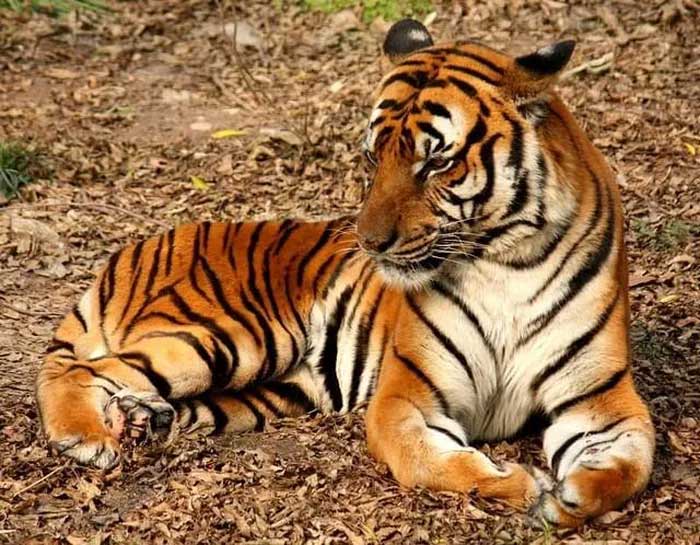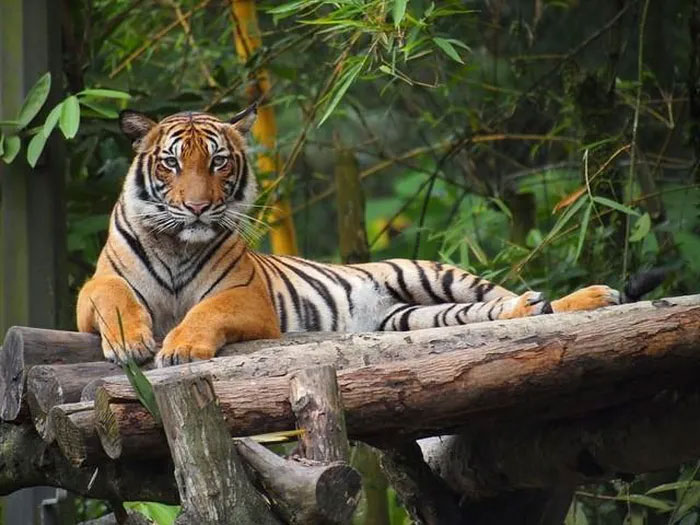Top 6 rarest tiger species on the planet
Tiger - the lord of the jungle is an animal symbolizing strength. The number of tigers in the wild has been steadily decreasing over the past decades. Currently, the number of tigers in the wild is less than 4,000.
The rarest tigers in the world
Tigers are a staple of zoos around the world and have fascinated humans for centuries. Yet despite all the affection, the tiger is one of the most critically endangered species in the world.
The following 6 rarest tiger species on the planet are all at risk of extinction at dangerous or critically endangered levels.
One species of tiger on this red list is even now considered extinct in the wild, with a small number of individuals in captivity.
While many factors contribute to the decline of wild tiger populations around the world, the biggest threat facing tigers is from human activities, including illegal hunting, habitat is shrinking and being killed by humans.
It is hoped that raising awareness of the tiger's current plight can contribute to the conservation of this symbol of strength.
1. South China Tiger
- Current projected numbers: Essentially extinct in the wild, but around 100 or more are living in captivity.
- Habitat: Southeast China - mainly in Hainan Wetlands.
- Current Conservation Status: Critically Endangered.
- Scientific name: Panthera tigris amoyensis.

The South China tiger is classified as the rarest in the world because it is essentially extinct in the wild.
The South China tiger has been declared "essentially extinct" in the wild by scientists, making it the rarest tiger species in the world. While the South China Tiger has not been seen in the wild for over 25 years, there are about 100 tigers in captivity and breeding programs are still underway.
It was previously thought that the captive population of the Chinese South Tiger was too small and lacked genetic diversity, but since the publication of a centralized guidebook a few years ago, there is some hope that the South China Tiger will China may be returned to the wild in the future.
In the early 1950s, it was estimated that there were about 4,000 wild South China tigers, but those numbers have dropped dramatically over several decades. Thousands of South China tigers have been killed as "pests" and many more have died because of habitat degradation.
The skull of the South China tiger is different from all other living tigers. The South China tiger is therefore considered to be the primordial tiger from which all other modern tigers have evolved.
2. Malayan Tiger (Malayan)
- Current projected number: 250 – 340.
- Habitat: Southern and central parts of the Malay Peninsula; southern tip of Thailand.
- Current Conservation Status: Critically Endangered.
- Scientific name: Panthera tigris jacksoni.

Malay Tiger.
Before 2004, the Malayan Tiger was classified in the same species as the Indochinese Tiger. However, after genetic analysis, it was determined that the Malayan Tiger was its own subspecies and it was named Panthera tigris jacksoni, in honor of Peter Jackson, a prominent (non-religious) tiger conservationist. famous film actor).
As its name suggests, the Malayan Tiger is mainly found in the southern and central parts of Peninsular Malaysia. There is also a small population of Malayan Tigers at the southern tip of Thailand. The biggest threat to the Malayan Tiger population is due to deforestation for excessive logging and road construction, which causes the forest to shrink.
In the Malay language, the Malayan Tiger is called harimau, often shortened to rimau.
3. Indochinese tiger
- Current expected number: about 350 animals
- Place of residence: Myanmar; Thailand; Laos; Vietnam; Cambodia; Southwest China (probably extinct in this area).
- Current conservation status: Dangerous.
- Scientific name: Panthera tigris corbetti.
The Indochinese tiger is native to Myanmar, Thailand, Laos, Vietnam, Cambodia and southwestern China. However, scientists think that the Indochinese tiger may have become extinct in China as no individuals have been seen in this area in recent years.
The study also suggests that there may not be any purebred Indochinese tigers left in Cambodia and Vietnam.

Currently, there are about 350 Indochinese tigers left.
Although all tiger species are quite mysterious, with Indochinese tigers they are solitary and very elusive, so little is known about this animal's behavior in the wild. Of all the remaining tiger subspecies, the Indochinese Tiger is the least representative in the captive population. Since the Malayan Tiger was separated into a subspecies of its own in 2004, the number of Indochinese tigers in zoos around the world is believed to be less than before.
The Indochinese Tiger's scientific name, Panthera tigris corbetti, pays homage to Jim Corbett, a British hunter who took down man-eating tigers and leopards in India, but later became a conservationist.
4. Sumatran Tiger
- Current expected number: 400 – 600.
- Habitat: Sumatra, Indonesia (Sunda Islands).
- Current Conservation Status: Critically Endangered.
- Scientific name: Panthera tigris sumatrae or Panthera tigris sondaica.

The Sumatran tiger is classified as critically endangered.
The Sumatran tiger is the last remaining super tiger species in Indonesia's Sundra Islands, which were once home to the Bali and Java Tigers - the Bali Tiger became extinct in the 1950s, while the Java Tiger was last seen in the late 1950s. 1980s.
The sources for the data vary, but it is estimated that there are between 400 and 600 Sumatran tigers left in the wild.
DNA analysis shows that the Sumatran Tiger became isolated from other tiger populations after sea level rise occurred between 12,000 and 6,000 years ago. Thus, the Sumatran Tigers have evolved differently and have no problem living on their home island.
The Sumatran Tiger population is declining mainly due to human activities such as the expansion of palm oil plantations.
The Sumatran tiger is the smallest tiger subspecies, and also has the darkest (dark orange) coat and highest striping density of any other tiger species.
5. Siberian Tiger
- Current expected number: 500 – 600.
- Habitat: Russian Far East; Northeast China; and possibly North Korea.
- Current conservation status: Dangerous.
- Scientific name: Panthera tigris altaica.
The Siberian or Amur tiger is mainly found in the dense forests of the Russian Far East, but also inhabits parts of Northeast China and possibly North Korea. In the past, the Siberian Tiger's range was much larger and could be found throughout the Korean Peninsula, northern China and Mongolia and in addition the Russian Far East.

Siberian tigers live in cold countries such as the Far East, China, and Mongolia. (image source: Wikimedia Commons).
Unfortunately, over-hunting has almost decimated the wild Siberian Tiger population, and its numbers have fluctuated over the years. After Russia became the first country to grant full protection to the Siberian tiger subspecies, its population has stabilized at more than 500, but less than 600.
In captivity, the Siberian tiger is the largest of the remaining tiger subspecies, growing up to 300 kg and 3.28 meters long. However, in the wild, the Siberian tiger will be larger in size.
6. Bengal tiger
- Current expected number: 2,603 – 3,346 heads.
- Habitat: Indian subcontinent (Bangladesh, Nepal and Bhutan).
- Current conservation status: Dangerous.
- Scientific name: Panthera tigris tigris.

The Bengal tiger lives in South Asia.
As the most numerous tiger subspecies, the Bengal tiger is present at zoos and wildlife parks around the world, and even at live shows in Las Vegas.
Although the number is more than the above 5 rare tiger species combined, the Bengal Tiger is still an endangered animal classified as dangerous. Like all tiger species, the Bengal Tiger population is in decline, mainly facing threats from humans, especially illegal poaching.
The reason for the high numbers (compared to other tiger subspecies) of the Bengal Tiger is that many have been bred in captivity since 1880 and have been extensively interbred with other tiger subspecies.
Above are 6 tiger species listed in the red list that need to be conserved worldwide. Hopefully, on the occasion of the New Year of the Tiger 2022, readers can choose for themselves the most favorite tiger species.
- This is the most special white tiger on the planet, the whole world has only one
- The first film about the rarest whale on the planet
- Science confirmed 9 species of tigers on Earth, 3 extinct species
- About to revive the extinct Persian tiger
- Mysterious land of giant tiger cubs
- Discover the world's rarest rabbits in Vietnam
- Hybrid butterfly between two different species
- Discover the oldest tiger species on Earth
- The mystery behind the lobster during the rare extreme is causing a storm?
- Dog breeding tiger lion
- Tiger set a record of more than 1,300km in 5 months
- Successfully propagated the Bengal white tiger in the Botanical Garden
 Animal 'suffering' after hibernation
Animal 'suffering' after hibernation Why do goats climb well?
Why do goats climb well? Scientists were surprised to see chimpanzees eating turtles
Scientists were surprised to see chimpanzees eating turtles Giant catfish died deadly due to drought in Thailand
Giant catfish died deadly due to drought in Thailand The world's largest 'cat', about the size of a saber-toothed tiger
The world's largest 'cat', about the size of a saber-toothed tiger  How terrifying was the fighting power of the primitive tiger?
How terrifying was the fighting power of the primitive tiger?  Video: 'Chamawat Demon' - The most dangerous tiger in the wild
Video: 'Chamawat Demon' - The most dangerous tiger in the wild  Close-up of Vietnam's 'Roman arena'
Close-up of Vietnam's 'Roman arena'  Super rare 'Black Tiger' in India, weighing over 500kg, easily took down a 4 meter long crocodile alone
Super rare 'Black Tiger' in India, weighing over 500kg, easily took down a 4 meter long crocodile alone  Tiger photos that surprised the world
Tiger photos that surprised the world 